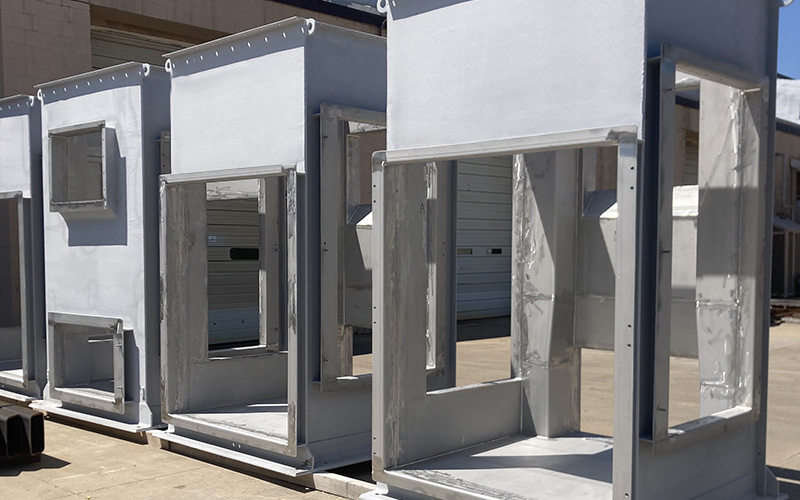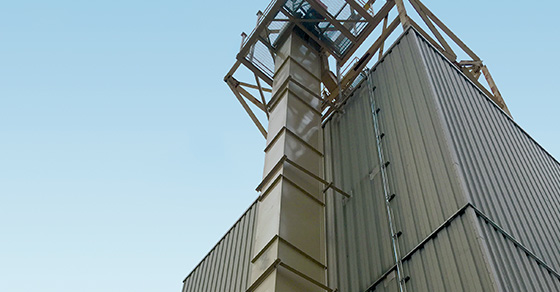Confusion often arises when sourcing a bucket elevator, with prices varying widely from one supplier to the next. The reason? The term “bucket elevator” is used to describe two fundamentally different types of equipment: agricultural bucket elevators (commonly called grain legs) and industrial bucket elevators.
While they may look similar at first glance, these two elevator types are engineered for very different materials, operating conditions, and performance expectations. For buyers in industrial markets, understanding this distinction is critical to selecting the right equipment—and avoiding costly downtime, rapid wear, or outright failure.
Agricultural vs. Industrial Bucket Elevators: What’s the Difference?
The main distinction comes down to level of duty. Agricultural bucket elevators are designed for use in grain handling applications where material is consistently free-flowing and low-abrasion. They are widely used in conveying materials like corn, soybeans, and wheat.
Industrial bucket elevators, by contrast, are built to handle a wide range of heavier, more abrasive, and sometimes corrosive materials, such as those found in the mining, chemical, power generation, and fertilizer industries.
These differences in application directly impact how the equipment is designed, built, and supported.
Ag Elevators
Designed for lower capacities and short, intermittent operating cycles, ag elevators employ a light-duty build with a one-size-fits-all approach to design; manufacturers stock prefabricated components and piece them together as needed.
These elevators are typically constructed from lighter-gauge galvanized sheet steel (often 14–16 gauge) and assembled using rivets or bolts instead of continuous welds. While this allows for mass production, low-cost installation, and fast delivery, it sacrifices the structural integrity needed for heavy-duty applications and long-term reliability.The use of rivets or bolts for assembly also allows for gaps in the casing, resulting in poorly sealed equipment.
While this is an efficient approach for elevators in an agricultural setting, it would be unsuitable in industrial applications where continuous operation, material variants, and extreme operating conditions require customized solutions.
Industrial Elevators
Industrial bucket elevators are required to withstand harsh, continuous operating conditions at high capacities. And even while “light-duty” industrial elevators are an option, this equipment is still expected to perform in a much more demanding setting than even the most robust ag elevator. Again, this is evident when examining equipment construction. An industrial elevator intended for long-term reliability is engineered around the specific material properties and facility parameters, with custom sizing and configuration, specialized materials of construction, and the incorporation of add-ons or modifications that increase the efficiency – and durability – of the elevator according to its unique production environment.
Application-specific requirements might mandate the use of:
- Alternative materials of construction
- Internal seal welds for minimizing dust and/or corrosion
- Custom service and access platforms
- Custom door locations and styles
- Dust pick-offs
- Instrumentation such as plugged-chute switches, bucket motion detectors, and shaft speed sensors
Further, to withstand its rigorous operational demands, industrial elevators utilize significantly larger, more heavy-duty parts and components; pulleys, chains, sprockets, drive assemblies, and belts must be extremely robust. Ag elevator components are small and light-duty in comparison.

Industrial bucket elevator casings
General Arrangement Drawings (GADs)
Another important, but often overlooked distinction resulting from the different approaches to agricultural and industrial elevators is the General Arrangement Drawing, or GA.
A GA is essential for industrial elevator planning and integration. It ensures the equipment fits correctly, performs reliably, and can be safely installed and maintained. While the GA assists in a number of key factors in an industrial setting – planning for foundation loads, civil construction needs, electrical requirements, and the like – the importance of a GA is perhaps most evident in the equipment’s integration into the facility and its interfacing with other equipment.
A GA ensures that the elevator interfaces properly with chutes, hoppers, or discharge points and avoids interference with existing structures, utilities, or walkways. Without a GA, teams may find that the elevator cannot be installed as planned—resulting in costly on-site modifications or unsafe conditions. This is especially problematic when the elevator must be integrated with surrounding equipment or installed on a structural support system.
Because ag elevators are a one-size-fits-all solution, they are not provided with a GA, though in some cases manufacturers may offer a GA at an additional cost. In contrast, a GA is a standard – and necessary – step in designing an industrial elevator.
Conclusion
At first glance, a grain leg and an industrial bucket elevator might look like interchangeable solutions—but the reality couldn’t be more different. Agricultural elevators are cost-effective and well-suited for handling free-flowing, low-abrasion materials in intermittent-use applications. But for industrial environments where uptime, safety, and performance are non-negotiable, these light-duty systems fall short.
Industrial bucket elevators are engineered from the ground up to meet the demands of harsh materials, continuous operation, and precise facility integration. They offer robust construction, specialized features, and essential documentation—like general arrangement drawings—that ensure long-term reliability and safety.
For buyers in mining, fertilizer, chemical, or power industries, choosing the right type of elevator isn’t just a matter of price—it’s a matter of performance, longevity, and operational success. This requires working with a partner that understands the demands of your process and can deliver a solution built to withstand them.
FEECO is a leading manufacturer of custom, heavy-duty bucket elevators for use in mining, chemical processing, and fertilizer production. We design each elevator according to the material it will handle and its expected level of duty. Our Customer Service Team offers continued support – including spare parts – after the sale, to ensure equipment continues to perform its best. For more information on our custom bucket elevators, contact us today!

